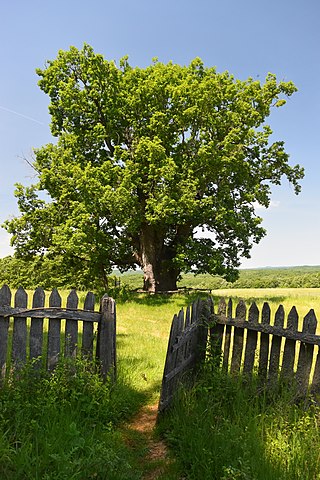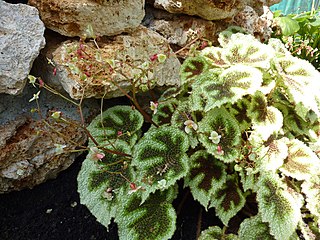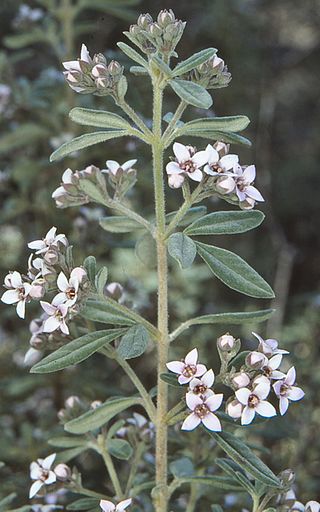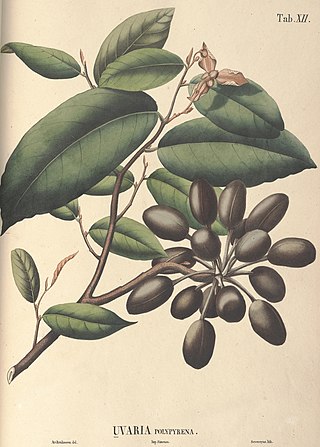
Sorrel, also called common sorrel or garden sorrel, is a perennial herbaceous plant in the family Polygonaceae. Other names for sorrel include spinach dock and narrow-leaved dock.

Quercus frainetto, commonly known as the Hungarian oak, is a species of oak, native to southeastern Europe and Turkey. It is classified in Quercus sect. Quercus.

Quercus ellipsoidalis, the northern pin oak or Hill's oak, is a North American species of oak tree native to the north-central United States and south-central Canada, primarily in the Great Lakes region and the Upper Mississippi Valley. It most commonly occurs on dry, sandy soils.

Kinilnat, or ensalada, is an Ilocano salad. Unlike the western concept of a salad, kinilnat is accompanied with the main course as a side dish.

Sonchus brassicifolius, synonym Dendroseris litoralis, is a species of flowering plant in the daisy and sunflower family Asteraceae. It is a small evergreen tree species known as the cabbage tree. It is endemic to the Juan Fernández Islands, which lie in the southeast Pacific, off the west coast of Chile. It is native only to the tiny, volcanic Robinson Crusoe Island, home of the famed Juania australis and many other endemic plants. The species is threatened by habitat loss and has been brought back from the brink of extinction. It had been reduced to only a few individuals by feral goats on the island, and is still considered critically endangered.

Goeppertia makoyana, also known as peacock plant or cathedral windows, is a species of plant belonging to the genus Goeppertia in the family Marantaceae, native to Espírito Santo state of eastern Brazil. It has gained the Royal Horticultural Society's Award of Garden Merit.

Olearia phlogopappa commonly known as the dusty daisy-bush or alpine daisy-bush is a species of flowering plant in the family Asteraceae that is commonly found in eastern New South Wales, Victoria and Tasmania. It is a small shrub with greyish-green foliage, daisy-like flowers in white, pink or mauve that can be seen from spring to late summer.

Bolbitis heteroclita is an aquatic fern species of Bolbitis, native to the Indochina region of tropical Southeast Asia.

Begonia masoniana, the iron cross begonia, is a species of plant in the family Begoniaceae, native to southern China and northern Vietnam. It was originally described from cultivated plants of unknown origin and was only much later rediscovered in the wild. It is a rhizomatous perennial begonia growing to 0.5 metres (20 in), bearing large, asymmetrical, textured green leaves covered in reddish hairs, with a prominent dark brown pattern in the centre of each leaf, reminiscent of the German Iron Cross. It produces small white flowers in erect panicles, but is cultivated mainly for its foliage effect. In temperate regions it must be grown under glass, or in a completely frost-free environment. Not to be confused with the similar looking species Begonia variegata, from Vietnam. Although sometimes (incorrectly) considered a Rex begonia, this species is classified in the related section Coelocentrum.

Nymphaea gigantea, commonly known as the giant waterlily or blue waterlily, is a perennial, herbaceous plant in the family Nymphaeaceae which is native to parts of northern and eastern Australia, and it has been widely cultivated elsewhere. It is an aquatic plant whose natural habitat is permanent and semi-permanent still water bodies

Aulacophora dorsalis is a species of beetles in the family Chrysomelidae.

Zieria cytisoides, commonly known as the downy zieria, is a plant in the citrus family Rutaceae and is endemic to eastern Australia. It is a bushy shrub with three-part, clover-like leaves and small clusters of pale to deep pink flowers with four petals and four stamens.

Asimina reticulata, the netted pawpaw, is a species of plant in the family Annonaceae. It is native to Florida in the United States.
Goniothalamus velutinus is a species of plant in the family Annonaceae. It is native to Borneo. Herbert Airy Shaw, the English botanist who first formally described the species, named it after the dense velvety hair on its branchlets and petioles.

Mitrephora polypyrena is a species of plant in the family Annonaceae. It is native to Java, the Lesser Sunda Islands, and Myanmar. Carl Ludwig Blume, the German botanist who first formally described the species using the basionym Uvaria polypyrena, named it after the many stones or seeds in its fruit.
Duckeanthus is a genus of plant in the family Annonaceae. It is native to Brazil. It contains a single species, Duckeanthus grandiflorus. Robert Elias Fries, the Swedish botanist who first formally described it, named it in honor of Adolpho Ducke who collected the specimen he examined, and its large flowers.

A tree in the family Fabaceae, Cynometra ramiflora is found in mangroves and flooded forests from New Caledonia in the western Pacific west to Queensland in Australia, New Guinea, Island Southeast Asia, and Tropical Asia as far west as India. Its wood is used for construction and fuel, and parts of plant are ascribed medicinal use.
Pimelodendron amboinicum is a tree species in the Euphorbiaceae family. It is found from the Solomon Islands in the southwest Pacific, west to Sulawesi in Indonesia. The timber is used locally, though larger-scale illegal logging is apparent.

Indigofera cassioides, the cassia indigo, is a species of flowering plant in the family Fabaceae. It is native to the Indian Subcontinent, Southeast Asia, southeast and south-central China, and Taiwan, and has been introduced to Sri Lanka and Kenya. Local artisans use its leaves to produce a blue dye.

Condylocarpon isthmicum is a species of plant in the Apocynaceae family. It is native to Argentina, Brazil, Paraguay and Uruguay. José Mariano de Conceição Vellozo, the botanist who first formally described the species, named it after the narrow neck connecting the two sections of its fruit.


















